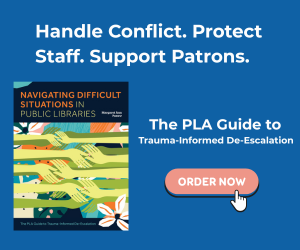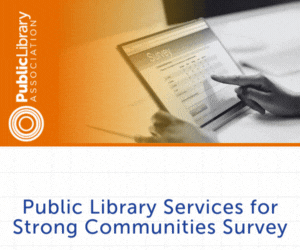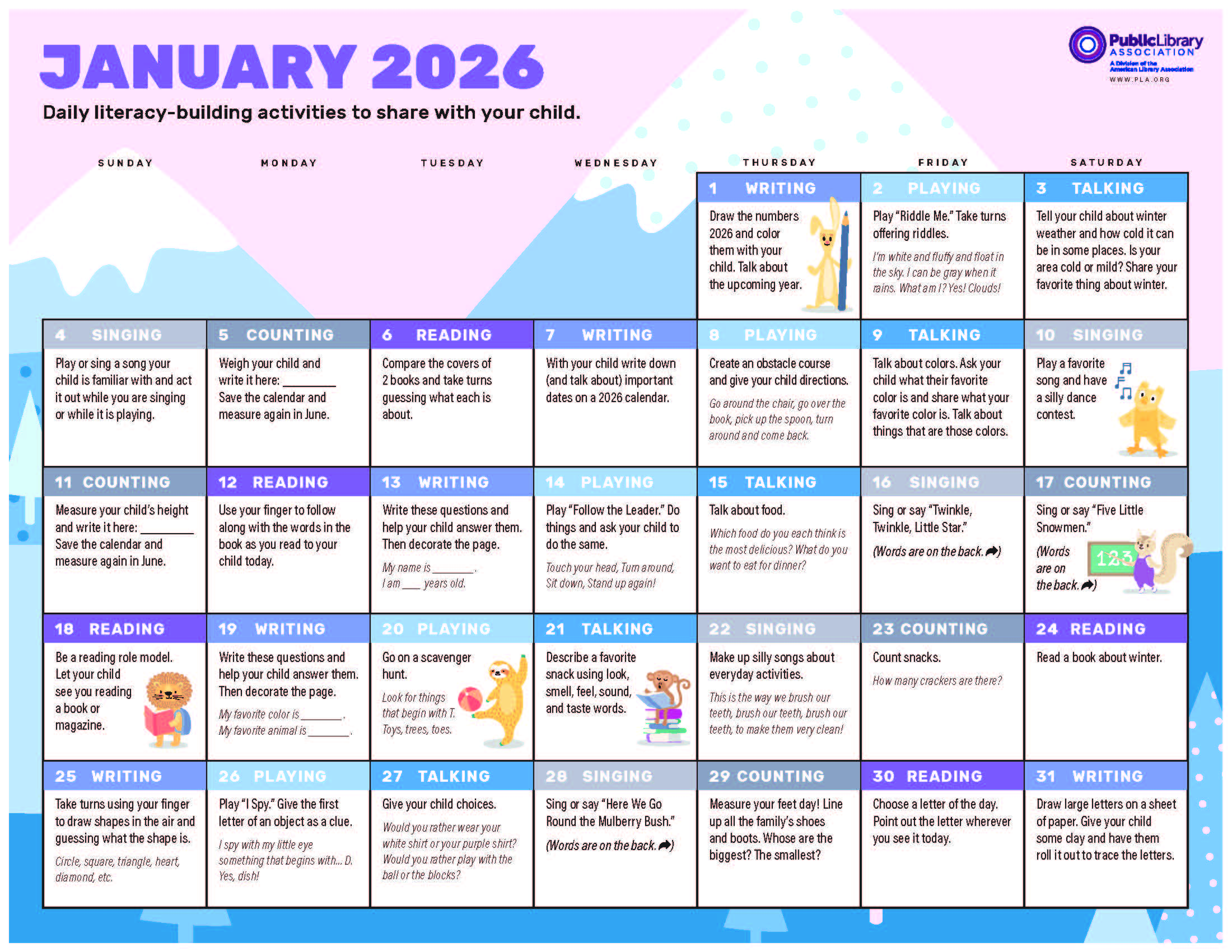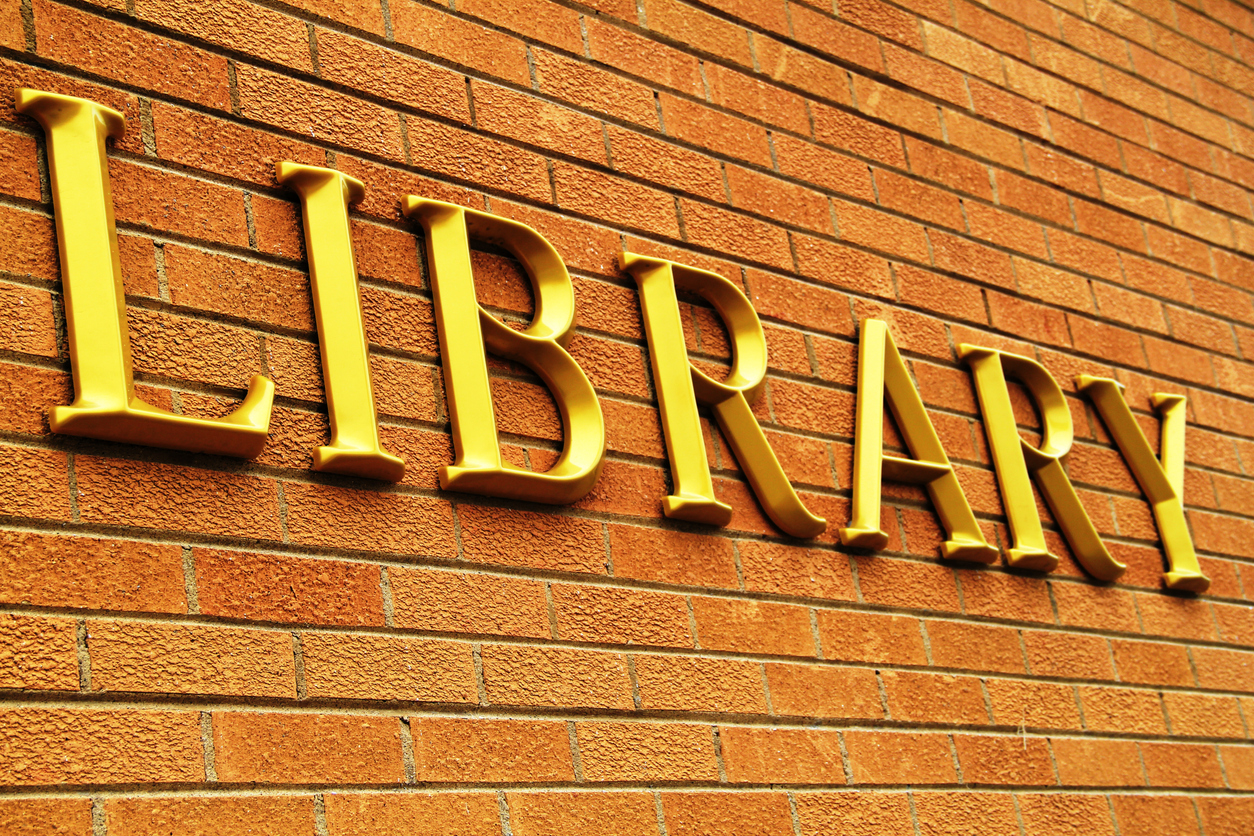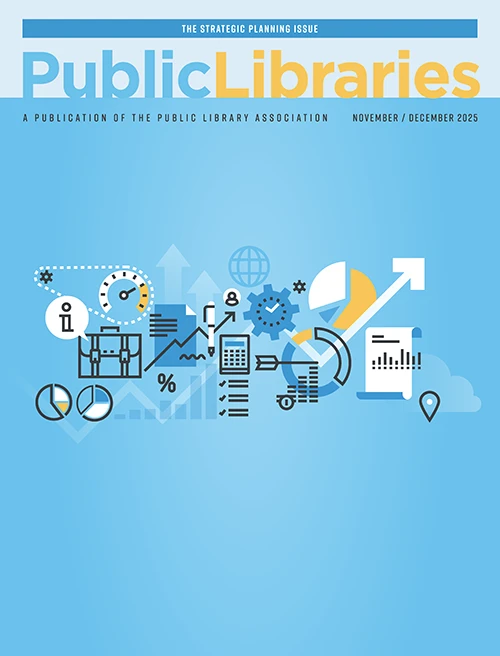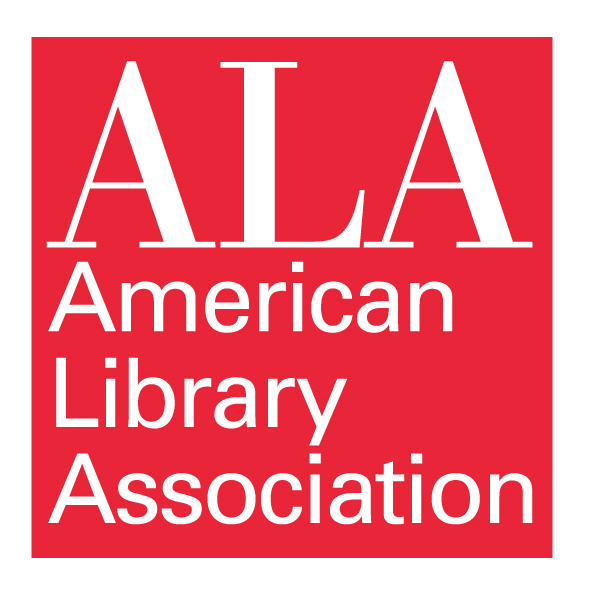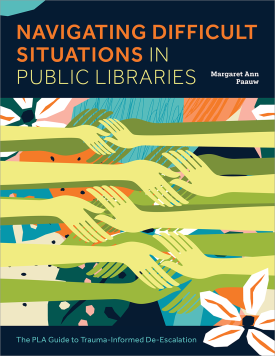Reaching Out: Library Services to the Developmentally Disabled
The desire to share what we learn with others is an integral part of our culture. Many Americans relish opportunities to discuss the latest book they just read or movie they just watched, but there is a segment of our population that has limited opportunities to do that. These individuals also are at high risk for unemployment and have a higher rate of poverty than the rest of the population.1 They are the developmentally disabled, who are often on waiting lists for any type of educational activity once they become adults.
The public library can be a place for this group to continue pursuing their natural desire to learn, experience stories, and share opinions and feelings. The Johnson County (Kans.) Library in suburban Kansas City has a long history of serving this population, winning an award in 2006 from the Association of Specialized and Cooperative Library Agencies (ASCLA), a division of the American Library Association (ALA), for services to the disabled population.2 In this article, we share three examples of programs that have been well received by this population: (1) a film discussion program, (2) a craft program called “Create!” and (3) a partnership with the local county agency that serves the developmentally disabled. All of these programs were created by frontline staff through conversations with agency personnel that provide services to the disabled.
Who They Are
People with developmental disabilities may be cognitively or physically impaired, or both. A good definition of the challenges this population face can be found on the webpage for the National Association Council on Developmental Disabilities:
While not always visible, these disabilities can result in serious limitations in everyday activities of life, including self-care, communication, learning, mobility, or being able to work or live independently. Such disabilities are almost sure to result in a lifetime of dependence on publicly funded services, unless families receive sufficient support, children receive appropriate education, and adults receive appropriate services that enable them to live and work in their local communities.3
According to the 2010 U.S. Census, approximately 15.2 million adults have difficulty with some kind of cognitive, mental, or emotional functioning.4 Other than dementia, the main causes of cognitive disabilities are Down syndrome (DS), autism spectrum disorder, and cerebral palsy.5 These are generally described as developmental disabilities. People with these disabilities commonly have limited options for educational opportunities once they become adults. Options for other stimulating daytime activities can be expensive or have long waiting lists. Often it is the television that becomes their best source for education and intellectual stimulation.
Why Help?
There is a twofold benefit for people with disabilities being in the library: (1) we can provide quality programs for them free of charge and (2) their presence can be a good influence on other patrons. Lisa Belkin, in her article “Should Down Syndrome Be Cured?” quotes a mother of two boys with DS who talks about the positive effect her sons have on other children at their school. “My experience with people with intellectual disabilities is that their lives enrich the lives of others and of the world around them in significant and irreplaceable ways. I see how their presence brings out compassion, kindness, even tenderness in the older kids at school.”6
Those who have not had a lot of exposure to the intellectually disabled may underestimate the ability of the disabled person to understand and discuss issues. Studies have shown that the emotional maturity of those with DS can rival that of a “typical” person of the same age.7 A DS infant develops emotionally at the same rate as a “normal” infant in all ways except the ability to detect fear.8 And a DS adult is no different from others in regard to the ability to recognize and appreciate emotions. They also have been found to have high self-esteem. The only regret they have about their disability is that it can keep them from doing “normal” things such as drive a car or get married.9
As a society, we have made a lot of progress in regard to including the developmentally disabled in our communities. Long ago, they were often kept away from the general population, hidden in institutions. In the 1950s things began to change when a group of parents formed an alliance to advocate for their children. They wanted their children to have opportunities for a better, more fulfilling life.10
This alliance led to the creation of a nonprofit organization now called The Arc. On its website, a timeline of six decades of activism for the developmentally disabled population illustrates The Arc’s work and progress. Here are some of their major accomplishments:11
- 1950s—The first organization to put money into research on intellectual and developmental disabilities; led to awareness of lead poisoning.
- 1970s—Advocated for the creation of the Supplemental Security Income program to provide income for persons with severe disabilities, and also advocated for the passage of a national housing law for low income individuals with disabilities.
- 1980s—Involved in creating several work incentives in the Social Security Act to allow more disabled individuals to work.
- 1990s—Advocated for the landmark Americans with Disabilities Act.
- 2010—Worked to ensure that students with disabilities were covered within the educational accountability system under the No Child Left Behind Act.
ALA also has been an active advocate for the developmentally disabled population. Here is an excerpt from ALA’s “Services to Persons with Disabilities: An Interpretation of the Library Bill of Rights,” which is inspirational in its wording:
The American Library Association recognizes that persons with disabilities are a large and often neglected part of society. . . . The library plays a catalytic role in their lives by facilitating their full participation in society.12
Another important resource is the Association of Specialized and Cooperative Library Agencies (ASCLA), a division of ALA. Although ASCLA targets all special populations (including the incarcerated and homeless), it has done a lot of work to provide libraries with the information they need to comply with the Americans with Disabilities Act. ASCLA is also a good resource for staff training on services to patrons with disabilities. For example, it has handy “Library Accessibility Tip Sheets” with an overview on how to serve this population.13
ASCLA can also be a source for funding. It offers $1,000 as part of its ASCLA/KLAS/NOD Award to a library that provides an innovative or well-organized project that successfully develops or expands services for people with disabilities.
Film Discussion Program
The De Soto Library is a 3,800-square-foot facility in a small community west of the Kansas City suburbs. Located right on the main street, it has a homey feel where everyone knows everyone.
Down the street is the school district’s Access House, an adult cooperative community education and support service program designed to help disabled students (ages 18-21) function effectively and independently in their community. Each year, at least one student is assigned to the library to learn job skills—emptying tubs, sorting materials, and so on.
De Soto librarian Janine Myers wanted to come up with a program the Access House group would enjoy while also providing them opportunities to share ideas and get experience participating in a typical adult discussion, which is a big part of typical American lives (think of gathering around the water cooler to discuss the latest new show). Myers knew a book discussion would be difficult due to group members’ varying reading levels, but she decided movies might work perfectly;
everyone can contribute something, even if it is as basic as “it was funny!”
It has been especially rewarding to hear the interesting observations that come from this group. For example, a favorite movie with the group was Temple Grandin, about the autistic woman who has become one of the top scientists in the humane livestock handling industry.
Group discussion focused on all the obstacles Grandin had overcome in her life and how important it was for her to have people who encouraged her to keep going when things got difficult. They also talked about how Grandin—through hard work and persistence—was able to turn derision into respect wherever she went.
All of the attendees said that they could relate to how Grandin felt in social situations and discussed how difficult it can be for them to navigate those interactions. One young man shared his thoughts simply and eloquently, “I liked it. It affected me.”
Another great example was their discussion of the movie Oklahoma. In this classic musical, a menacing bully tries to break up a romance between a cheerful, friendly ranch hand and a farmer’s daughter. Everyone enjoyed the musical format and had a favorite song. All thought the main theme was learning to get along, even when you don’t agree.
One member said the scene with the pictures of the girls on the wall of the bunkhouse made him feel uncomfortable and made the character of Judd creepy. This led to an interesting discussion of what would happen if that scene were removed from the movie, how it would change the movie, and what might replace it to keep Judd “creepy.”
At the end, everyone had a great time discussing what kind of movie they might make of Access House—would they do a musical and, if so, with what songs? One member suggested a zombie movie and another suggested one about superheroes, or maybe a zombie movie with superheroes to defeat the zombies. They all became very animated and involved in this part of the discussion.
A unifying part of the discussion usually involves having the students come to consensus about the main point of the movie. For example, with the movie Balto (about a lead sled dog that must overcome villainy to deliver a vaccine to a town in need), the group determined the central theme was about not judging people by what others say about them, but to make your own judgment from your own interactions with them.
Myers has compiled a list of best practices from the first three years:
- She recommends planning the entire season before the discussion year starts. She sits down with the teachers to select appropriate movies together. They work around themes and world events so that the students will be more aware of what is going on in the world. For instance, they watched the movie Dave during the 2012 presidential election. They pick some movies that feature people with a disability (Temple Grandin, Radio, Dolphin).
- The students munch on popcorn and watch the movie together at Access House the day or week before the library discussion. The students really enjoy that.
- One year, the group had a campaign to encourage people not to use the word “retarded.” Another time, the group had a recycling campaign. Whenever possible, Myers tries to tie in elements from the film to the current campaign.
- Many of the Access House students have a younger developmental age than their chronological age, thus films cannot contain adult themes or language.
- One of the students is higher functioning, enjoys talking, and can dominate the discussions. He is assigned to research something from each movie and share it with the group as a learning experience. For example, the movie Balto involves Diphtheria, so he researched that.
- It’s helpful to start discussions by asking a general question about the movie, such as “What character did you like most / least?” and let each student respond. If a student says he/she didn’t like a certain part or character, Myers tries to get them to talk about how removing that element would change the movie. Flexibility is important because often the next question will flow from the answers to the previous question. She has found it fun to ask how they would make a computer game from the movie, as there are a few who are into computer games.
- The paraprofessional aides that attend with the group are a necessity, because they can intervene when a client gets upset. Some of the students can be emotional, while others are very distant. The verbal abilities of the members also vary widely, and the paraprofessionals often help to bridge that gap.
Editor’s note: A complete list of the movies they have watched and a brief summary of each discussion is available; e-mail Myers at myersj@jocolibrary.org for more information.
“Create!” for Special Populations
Several years ago a group of senior adults with developmental disabilities from the county agency Johnson County Developmental Supports (JCDS) began visiting the midsize suburban Lackman Library on a regular basis to check out books, videos, and music. Sharon Holley, the senior direct support professional at the time, noticed the library’s craft programs for children were skill level-appropriate for these adults, but she was concerned that the children would feel uncomfortable if the adults participated.
When Holley shared these thoughts with then-branch manager Helen Hokanson, Hokanson responded by arranging for a duplicate program for the adults with developmental disabilities so they would feel comfortable and welcomed in attending. With the help of library staff, the adults participated in one of two monthly sessions of Create! to practice fine motor skills and decision-making in creating thematic crafts. Having their own sessions has made these adults feel at ease, and the professional caregivers are pleased about the cognitive development and self-esteem that the class provides for their clients.
Although at the beginning most of the participants were associated with JCDS, news about the program spread quickly to other developmentally disabled groups and individuals, and there was often a waiting list for the twenty-five spots per class. The description for the program was “Discover your creative side, make new friends, and have fun when you join us for an hour of exploring the arts! This program is targeted at adults with special needs or learning disabilities.”
The program content for Create! is similar to any library crafts program for preschool children. Youth services specialist Gloria Liposchak produced the program for several years. She would sometimes read a children’s book or do storytelling, sometimes with music, but always with thematic crafts. For instance, at Thanksgiving the group made turkeys and Liposchak read the children’s book Run, Turkey, Run by Diane Mayr. One winter, they read Snowmen at Night by Caralyn Buehner and made snowmen out of baby food jars.
Sometimes Liposchak used books as a jumping-off place for the art. For example, she used Lois Ehlert’s books to illustrate collage, then encouraged participants to make totally different collages; compared Ehlert’s sharp edges and brighter colors to Eric Carle’s fuzzy and faded art work; and kept more author-illustrator books on hand for the participants to explore.
Liposchak found preschool-level activities to be the most suitable for the participants’ abilities. When sessions were about just the art, Liposchak focused on using a variety of media, techniques, and processes to express participants’ ideas. Using rounded-tip scissors, markers, colored pencils, and other craft items, the participants could make their own creations.
Ideas were easy to find by searching online sources, magazines, and books, although she also picked up ideas from store display windows and card stores. To put the program together, she gathered or purchased materials, ordered die-cuts from the children’s department staff, and made samples to display and show to the participants as a guide.
The challenges in offering this program fall into two categories: (1) balancing disabilities and adult status in planning the programs, and (2) accommodating the very wide range of abilities among the participants.
The adaptation of preschool-level activities for these adults is always on Liposchak’s mind—because they are adults. She said, “When we read a story, I try to find books that have an adult appeal. Even though the participants have learning disabilities, I am always cognizant that they are adults. I would never want to insult them by having materials on too low a level. They recognize baby stuff when they see it. That is why I try to be judicious with my craft selection, too.”14 Therefore, it’s a goal to prepare programming that these adults can accomplish with success while respecting their status as adults.
The second challenge—the wide span of abilities—occurs in the sessions. One or two participants in each group are in wheelchairs, sometimes with very limited motor skills. Others use walkers or need assistance in navigating the library. A few lack verbal skills and communicate through sounds and gestures. A ratio of one adult to every five or six participants is needed, and JCDS provides staff to meet that goal. We have also used volunteers to help, especially with setup and cleanup.
Most participants are at a higher level of ability and are very articulate. Some can read and write; others cannot. However, most have difficulty with fine motor skills, and some of the participants need firm directions. Most have difficulty using scissors, but Liposchak always encourages them to try before asking for help. Patience and flexibility are the keys for a successful program.
Lackman Library won an achievement award in 2007 through the National Association of Counties for this program due to its success in filling a gap in both library and community programming for this population.
Flower Pens, Bookmarks, and Containers, Oh My!
There is a community service group within JCDS that provides opportunities for about forty of their clients to give back to their community through volunteerism. The group members volunteer their time and/or make useful items for various businesses and organizations within the county. A perfect collaboration is the joint project where the group members make flower pens and colorful bookmarks for us to use at the library.
The pens and pencils look fun and attractive out in the library—plus, it makes it easier for patrons to remember they are “borrowing” a pen and to return it. The bookmarks are a fun giveaway item at the checkout desk. Children enjoy looking through them and picking their favorites.
The items are usually seasonal, such as pens that are attached to colorful flowers in the spring. They have lots of fun coming up with ideas for colorful “pots” to put the pens in, such as the yellow chick pen holder as shown above. They use either cans or glass jars for these. The clients at JCDS get really creative around the holidays with “ghosts” on the ends of pencils at Halloween and hearts hanging down from pens at Valentine’s Day.
The library receives a fresh batch of craft items each month, and we take turns sending them to various branches throughout the Johnson County system. Stacy Geyer says that the JCDS clients are so proud of being able to display what they make. “The purpose of our Community Service Program is to teach our clients about the importance of giving back to their community,” said Geyer.”15
Using the Library
We have been told that a trip to the library is one of the favorite things for a developmentally disabled person to do. Sherry Meyer, an instructor at Access House, explained, “They like to check things out. They feel independent, just like their peers. The library feels like such a safe place to them once they know the staff. It is also good for other people to see them, to realize that there are disabled people in their communities.”16
The library can also be a good place for the developmentally disabled to learn responsibility. The students from Access House visit the library each week, and the instructors do not remind the students when their materials are due, but limit each student to three things checked out at a time. The students may forget once to return something on time, but they have not had a student make that mistake more than once. It helps that the students go to the library on the same day each week.
Wrapping Up
Lifelong learning is a common goal for adults, but the developmentally disabled community has limited options to do so. “The biggest challenge we have is to find resources in the community for our clients to meet their goals and pursue their passions,” said Geyer.17
The addition of programming to this population may make staff feel uncomfortable due to unsure expectations or fear. When asked what she would most like librarians to know about this community, Geyer said, “Just give them a chance. So many people have a fear of the unknown with this population. If you spend some time with them, you will see how unique they each are.”18
If you are looking for further inspiration for library programs for this population, be sure to check out Contra Costa County (Calif.) Library and its “Insiders” program. It was originally designed to encourage adults with developmental disabilities to feel comfortable navigating through the library, using available resources, and communicating with staff members. It now includes many different types of programs. They have a video linked on their “Insiders” webpage that tells all about their services to the disabled community.19
One final point regarding the validity of serving this population—the population is increasing. According to the Centers for Disease Control and Prevention, the prevalence of developmental disabilities increased 17.1 percent from 2006 to 2008 compared to a decade earlier.20 That is an increase of 1.8 million developmentally disabled children in the United States within a twelve-year period.
Like everyone, the developmentally disabled community wants a safe place to continue learning, sharing, and growing intellectually throughout their lives. The public library is in a unique position to be that place, and the rewards will be great for the whole community.
References
- Matthew W. Brault, Americans with Disabilities: 2010: Household Economic Status. (Wash., D.C.: United States Census Bureau, 2012): 70–131.
- Association of Specialized and Cooperative Library Agencies, “ASCLA Exceptional Service Award,” accessed May 21, 2014.
- “National Association of Councils on Developmental Disabilities,” NACCD, accessed Feb. 11, 2014.
- Brault, Americans with Disabilities: 2010.
- Heather Wray, “Protecting the Rights of the Most Vulnerable by Creating a Culture of Inclusion,” Feliciter 59, no. 3 (June 2013): 26–30.
- Lisa Belkin, “Should Down Syndrome Be Cured?” Motherlode: Adventures in Parenting (blog) New York Times Parenting Blogs, Jan. 10, 2010, accessed May 21, 2014.
- Regis Pochon and Christelle Declercq, “Emotion Recognition by Children with Down Syndrome: A Longitudinal Study,” Journal of Intellectual & Developmental Disability 38, no. 4 (Dec. 2013): 332–43.
- J. G. Wishart, “Socio-Cognitive Understanding: A Strength or Weakness in Down’s Syndrome?” Journal of Intellectual Disability Research 51, no. 12 (Dec. 2007): 996–1,005.
- Cliff Cunningham and Sheila Glenn, “Self‐Awareness in Young Adults with Down Syndrome: I. Awareness of Down Syndrome and Disability,” International Journal of Disability, Development and Education 51, no. 4 (Dec. 2004): 335–61.
- “The Arc: For People with Intellectual & Developmental Disabilities,” accessed Feb. 11, 2014.
- Ibid.
- American Library Association, “Services to Persons with Disabilities: An Interpretation of the Library Bill of Rights,” ALA Council, Jan. 28, 2009, accessed May 15, 2014.
- Association of Specialized and Cooperative Library Agencies, “Library Accessibility –What You Need to Know,” accessed Sept. 25, 2014.
- Gloria Liposchak, personal interview with the author, Nov. 1, 2013.
- Stacy Geyer, personal interview with the author, Feb. 7, 2014.
- Sherry Meyer, personal interview with the author, May 14, 2014.
- Geyer personal interview with the author, Feb. 7, 2014.
- Ibid.
- Contra Costa County Library, “Insiders: Toolkit for Librarians to Plan and Implement Library Programs for Adults with Developmental Disabilities,” accessed Feb. 11, 2014.
- “Developmental Disabilities Increasing in US,” Centers for Disease Control and Prevention, June 14, 2011, accessed May 21, 2014.
Tags: community engagement, services to the developmentally disabled


